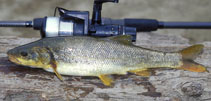http://www.fishbase.org/Summary/speciesSummary.php?genusname=Ptychocheilus&speciesname=oregonensis ---> http://192.134.151.83/Summary/speciesSummary.php?genusname=Ptychocheilus&speciesname=oregonensis
http://192.134.151.83/Summary/speciesSummary.php?genusname=Ptychocheilus&speciesname=oregonensis ---> https://fishbase.mnhn.fr/Summary/speciesSummary.php?genusname=Ptychocheilus&speciesname=oregonensis
https://fishbase.mnhn.fr/Summary/speciesSummary.php?genusname=Ptychocheilus&speciesname=oregonensis ---> https://fishbase.mnhn.fr/summary/Ptychocheilus-oregonensis.html
Ptychocheilus oregonensis, Northern pikeminnow : gamefish, aquarium

You can
sponsor
this page
Common name (e.g. trout)
Genus + Species (e.g. Gadus morhua)
-

-
About this page
-
Languages
-
User feedbacks
-
Citation
-
Uploads
-
Related species
-


 Northern pikeminnow
Upload your
photos
and
videos
Northern pikeminnow
Upload your
photos
and
videos
Pictures
|
Google image
 Ptychocheilus oregonensis
Ptychocheilus oregonensis
Picture by
JJPhoto
Teleostei (teleosts) >
Cypriniformes
(Carps) >
Leuciscidae
(Minnows) > Laviniinae
Etymology:
Ptychocheilus:
Greek, ptyx, ptychos = fold + Greek, cheilos = lip (Ref.
45335
)
;
oregonensis:
oregonensis
meaning - of Oregon (Ref.
1998
)
.
More on author:
Richardson
.
Environment: milieu / climate zone / depth range / distribution range
Ecology
Freshwater; benthopelagic. Temperate; 55°N - 39°N
North America: Pacific drainages from Nass River in British Columbia, Canada to Columbia River in Nevada, USA; Harney River basin in Oregon, USA; Peace River system (Arctic basin) in British Columbia and Alberta, Canada.
Size / Weight / Age
Maturity: L
m
?
range ? - ? cm
Max length : 63.0 cm TL male/unsexed; (Ref.
5723
); common length : 22.0 cm TL male/unsexed; (Ref.
12193
); max. published weight: 13.0 kg (Ref.
1998
); max. reported age: 11 years (Ref.
72462
)
Dorsal
soft rays
(total): 9-10;
Anal
soft rays
: 8 - 9;
Vertebrae
: 44 - 46. Mot deep bodied, greatest depth 16.6% (TL), belly gently rounded in mature individuals. Head moderately long, its length 22.8% (TL); eye small in adults, 17.6% of head length, but larger in young 7.6 cm long, when 25.2% of head length; snout long, 33.1% of head length of adults; interorbital width 29.6% of head length; mouth large, extending back to below anterior margin of eye. All fins clear. Pelvic axillary process usually a ridge. Peritoneum present. Nuptial tubercles fine, on head and back, on pectoral and pelvic fins and sometimes on the caudal fin. Dark green or green-brown dorsally becoming silvery white or cream ventrally. The lower fins of the males become yellow or yellow-orange during spawning period (Ref.
1998
). Dorsal fin usually with 9 rays; anal fin with 8 rays; 48-72, usually 51-62, scales on back from head to dorsal fin; 64-79, usually 66-75, scales on lateral line; and 12-20 scales above lateral line (Ref.
86798
).
Found in lakes, pools and occasionally in runs of small to large rivers. Large individuals occur in deep water (Ref.
5723
,
86798
). Feeds on fishes, terrestrial insects, plankton, aquatic insect larvae, and crustaceans while inshore; feeds mostly on fishes while offshore (Ref.
1998
). Male squawfish, prickly sculpins, and newts prey on the eggs (Ref.
1998
). Edible but not well appreciated (1998).
Life cycle and mating behavior
Maturity
|
Reproduction
|
Spawning
|
Eggs
|
Fecundity
|
Larvae
A female is surrounded by males close to the bottom; eggs and sperm are released at the same time and eggs settle in the gravel.
Page, L.M. and B.M. Burr
, 2011. A field guide to freshwater fishes of North America north of Mexico. Boston : Houghton Mifflin Harcourt, 663p. (Ref.
86798
)
IUCN Red List Status (Ref.
130435
)
Least Concern (LC)
; Date assessed:
01 March 2012
CITES
Not Evaluated
Not Evaluated
Threat to humans
Harmless
Human uses
Gamefish: yes; aquarium: public aquariums
FAO - Publication:
search
|
FishSource
|
More information
Countries
FAO areas
Ecosystems
Occurrences
Introductions
Stocks
Ecology
Diet
Food items
Food consumption
Ration
Common names
Synonyms
Metabolism
Predators
Ecotoxicology
Reproduction
Maturity
Spawning
Spawning aggregation
Fecundity
Eggs
Egg development
Age/Size
Growth
Length-weight
Length-length
Length-frequencies
Morphometrics
Morphology
Larvae
Larval dynamics
Recruitment
Abundance
BRUVS
References
Aquaculture
Aquaculture profile
Strains
Genetics
Electrophoreses
Heritability
Diseases
Processing
Nutrients
Mass conversion
Collaborators
Pictures
Stamps, Coins Misc.
Sounds
Ciguatera
Speed
Swim. type
Gill area
Otoliths
Brains
Vision
Tools
E-book
|
Field guide
|
Identification keys
|
Length-frequency wizard
|
Life-history tool
|
Point map
|
Classification Tree
|
Catch-MSY
|
Special reports
Check for Aquarium maintenance
|
Check for Species Fact Sheets
|
Check for Aquaculture Fact Sheets
Download XML
Summary page
|
Point data
|
Common names
|
Photos
Internet sources
AFORO (otoliths) |
Alien/Invasive Species database
|
Aquatic Commons
|
BHL
|
Cloffa
|
BOLDSystems
|
Websites from users
|
Check FishWatcher
|
CISTI
|
Catalog of Fishes
:
genus
,
species
|
DiscoverLife
|
ECOTOX
| FAO - Publication:
search
|
Faunafri
| Fishipedia |
Fishtrace
| GenBank:
genome
,
nucleotide
|
GloBI
|
Google Books
|
Google Scholar
|
Google
|
IGFA World Record
|
MitoFish
|
Otolith Atlas of Taiwan Fishes
|
Public aquariums
|
PubMed
| Reef Life Survey | Socotra Atlas |
Tree of Life
| Wikipedia:
Go
,
Search
|
World Records Freshwater Fishing
|
Zoological Record
Estimates based on models
Phylogenetic diversity index (Ref.
82804
): PD
50
= 0.5625 [Uniqueness, from 0.5 = low to 2.0 = high].
Bayesian length-weight: a=0.01072 (0.00429 - 0.02678), b=3.02 (2.80 - 3.24), in cm total length, based on LWR estimates for this species & (Sub)family-body (Ref.
93245
).
Trophic level (Ref.
69278
): 4.2 ±0.4 se; based on diet studies.
Generation time: 13.6 ( na - na) years. Estimated as median ln(3)/K based on 2
growth studies.
Resilience (Ref.
120179
): Low, minimum population doubling time 4.5 - 14 years (K=0.08-0.21).
Fishing Vulnerability (Ref.
59153
): Moderate to high vulnerability (50 of 100).
Back to Search
Random Species
Back to Top
Accessed through:
Not available
FishBase mirror site :
localhost
Page last modified by :
mrius-barile
- 20 July 2016
Fatal error
: Uncaught ArgumentCountError: Too few arguments to function checkEcotox(), 1 passed in /var/www/html/summary/speciessummary.php on line 2304 and exactly 3 expected in /var/www/html/includes/speciessummary.lib.php:2579 Stack trace: #0 /var/www/html/summary/speciessummary.php(2304): checkEcotox() #1 {main} thrown in
/var/www/html/includes/speciessummary.lib.php
on line
2579
|